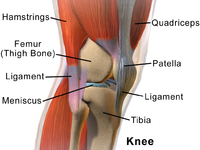
Baseline knee adduction moment interacts with body mass index to predict loss of medial tibial cartilage volume over 2.5 years in knee Osteoarthritis
Sign Up to like & getrecommendations! Published in 2017 at "Journal of Orthopaedic Research"
DOI: 10.1002/jor.23564
Abstract: This study aimed to determine the extent to which changes over 2.5 years in medial knee cartilage thickness and volume were predicted by: (1) Peak values of the knee adduction (KAM) and flexion moments; and… read more here.
Keywords: volume; knee osteoarthritis; cartilage; cartilage volume ... See more keywords

CNN‐based fully automatic wrist cartilage volume quantification in MR images: A comparative analysis between different CNN architectures
Sign Up to like & getrecommendations! Published in 2022 at "Magnetic Resonance in Medicine"
DOI: 10.1002/mrm.29671
Abstract: Automatic measurement of wrist cartilage volume in MR images. read more here.
Keywords: cnn based; cartilage volume; wrist cartilage;

Quadriceps muscle strength at 2 years following anterior cruciate ligament reconstruction is associated with tibiofemoral joint cartilage volume
Sign Up to like & getrecommendations! Published in 2022 at "Knee Surgery, Sports Traumatology, Arthroscopy"
DOI: 10.1007/s00167-021-06853-9
Abstract: Quadriceps strength deficits following anterior cruciate ligament reconstruction (ACLR) are linked to altered lower extremity biomechanics, tibiofemoral joint (TFJ) space narrowing and cartilage composition changes. It is unknown, however, if quadriceps strength is associated with… read more here.
Keywords: strength; cartilage; knee; pathology ... See more keywords

Conventional MRI-derived subchondral trabecular biomarkers and their association with knee cartilage volume loss as early as 1 year: a longitudinal analysis from Osteoarthritis Initiative
Sign Up to like & getrecommendations! Published in 2022 at "Skeletal Radiology"
DOI: 10.1007/s00256-022-04042-4
Abstract: To study associations between MRI-derived subchondral trabecular biomarkers obtained from conventional MRI sequences and knee cartilage loss over 12 and 24 months, using the FNIH osteoarthritis (OA) biomarkers consortium. Data of the 600 subjects in… read more here.
Keywords: subchondral trabecular; trabecular biomarkers; loss; volume loss ... See more keywords

The interaction between weight and family history of total knee replacement with knee cartilage: a 10-year prospective study.
Sign Up to like & getrecommendations! Published in 2017 at "Osteoarthritis and cartilage"
DOI: 10.1016/j.joca.2016.10.013
Abstract: OBJECTIVE Although being overweight or obese is an important risk factor for the development of knee osteoarthritis (OA), the interplay between weight and genetic factors remains unclear. This study aimed to examine the associations between… read more here.
Keywords: knee replacement; knee cartilage; knee; cartilage ... See more keywords

Hyaluronan derivative HYMOVIS® increases cartilage volume and type ii collagen turnover in osteoarhritic knee: data from MOKHA study
Sign Up to like & getrecommendations! Published in 2019 at "BMC Musculoskeletal Disorders"
DOI: 10.1186/s12891-019-2667-0
Abstract: BackgroundThe objective of this pilot study was to identify biological, clinical or structural biomarkers of an intra-articular hyaluronic acid injection efficacy (HYMOVIS®) for the design of a larger placebo-controlled clinical trial studying the disease-modifying activity… read more here.
Keywords: hymovis; piianp; type collagen; cartilage ... See more keywords

A Machine Learning Model to Predict Knee Osteoarthritis Cartilage Volume Changes over Time Using Baseline Bone Curvature
Sign Up to like & getrecommendations! Published in 2022 at "Biomedicines"
DOI: 10.3390/biomedicines10061247
Abstract: The hallmark of osteoarthritis (OA), the most prevalent musculoskeletal disease, is the loss of cartilage. By using machine learning (ML), we aimed to assess if baseline knee bone curvature (BC) could predict cartilage volume loss… read more here.
Keywords: machine learning; cartilage; bone curvature; knee ... See more keywords